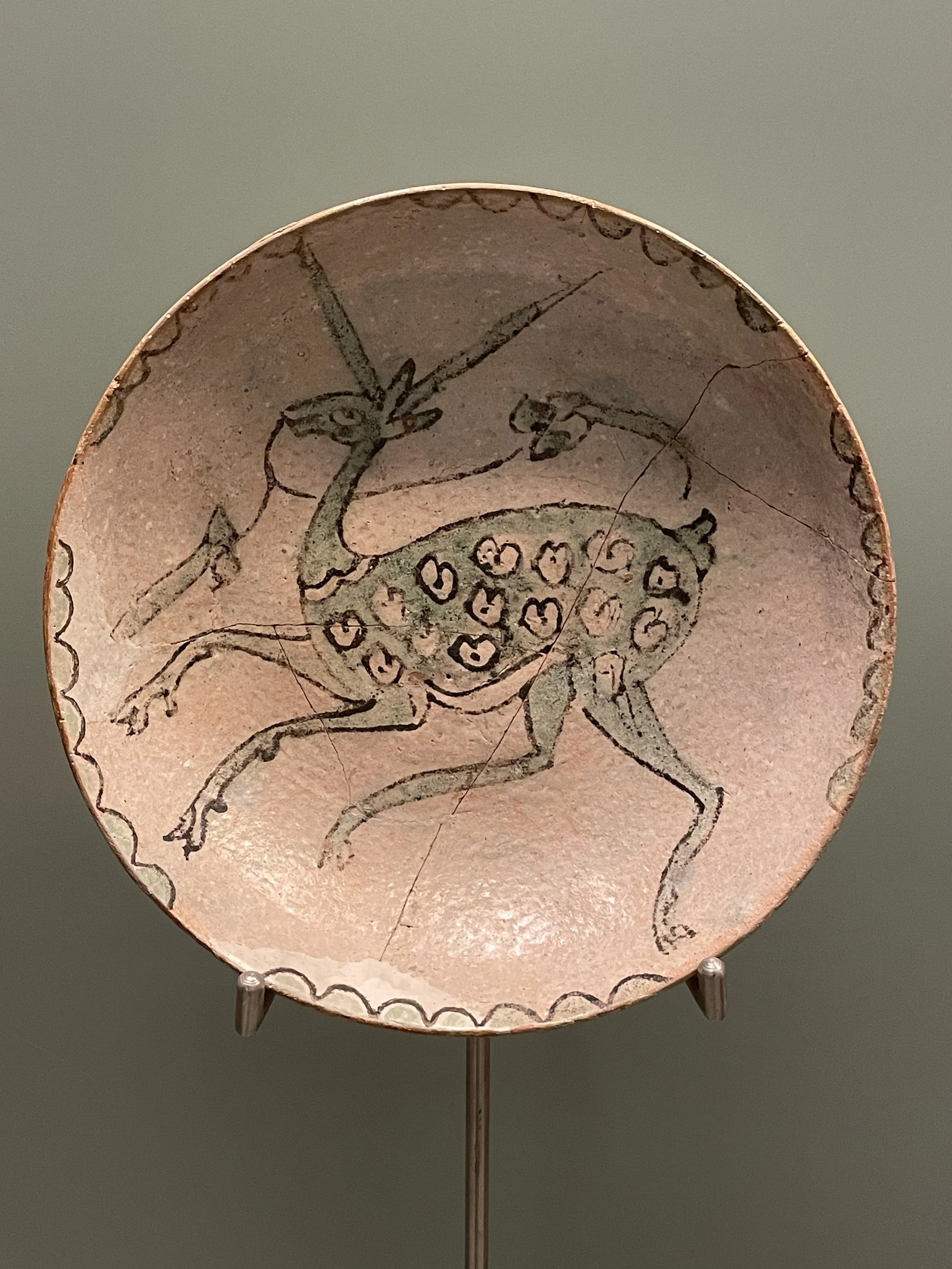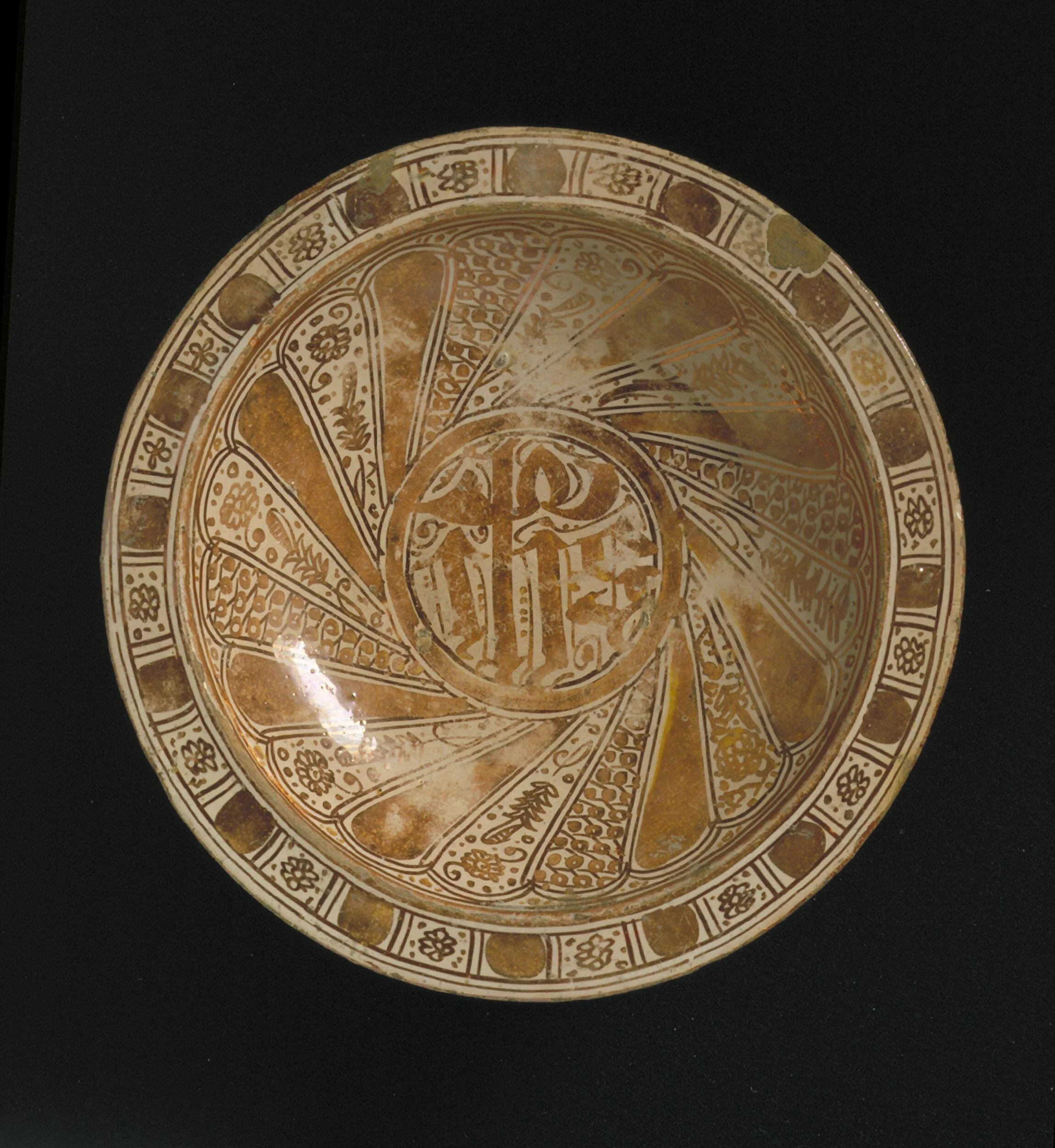Lustrous Clay: Hispano-Moresque Ceramics
From the Middle Ages, potters in the Middle East and Europe had one common pursuit: hard, white bodies. Not the human kind, the ceramic kind. For centuries, the Chinese had produced and exported porcelain: white clay that fired to a resilient, translucent body and was so desirable that wealthy collectors called it “white gold”. While porcelain remained elusive, potters sought aesthetic alternatives and in 9th-century Baghdad, they developed a passable, if imperfect, solution: tin-glazed earthenware.
Earthenware, made from locally available clay, is—as the name implies—earthy-colored, gritty, and produces relatively thick-walled objects. Covering the pots in glaze and firing it to a shine helps, but before the innovations of the 9th century, those glazes were transparent or dully colored. The results were not the particularly attractive. In Baghdad, the potters hit on the idea of adding tin oxide to their glaze which produced an opaque white covering. Not only did it resemble porcelain, it provided a blank canvas on which to paint polychrome decoration, just like Chinese blue and white porcelain. While it was a vast aesthetic improvement, the pots and plates were still thicker than porcelain and the glaze was prone to chipping, exposing the earthy clay beneath. While Muslim and European potters created tin-glazed earthenware objects of remarkable beauty, the pursuit of porcelain continued.
Plate, Muslim, 10th century
National Ceramics Museum, València
Technique Insight: Tin-glazed Earthenware
Tin-glazed earthenware pottery required two firings to produce a finished pot. The first firing occurred after the potter formed the clay into a vessel, either by hand-throwing it on a wheel or by pressing it into a plaster mold. The vessel was then fired to 1000°C to achieve what is called the biscuit state. The potter then dipped the vessel in an under glaze of lead glaze containing tin oxide. Once the tin glaze dried, it provided an ideal surface for applying an over glaze of colored pigments for decoration. The colored glazes were mainly produced by adding metallic oxides to a lead glaze: cobalt produced blue, manganese produced brown, and copper produced green. The painter used animal-hair brushes to carefully apply patterns or figures to the vessel. The pigment would immediately absorb into the tin glaze and, prepared properly, would not spread during the second firing, allowing for remarkably detailed painting. In the final step, the potter sprinkled a transparent glaze on the vessel to create a hard, shiny surface on the finished piece. The vessel was then fired to 950°C to vitrify the over glaze.
At the same moment in the 9th century these potters developed their second great contribution to ceramic history: lusterware. In the realm of medieval luxury goods, a metal object was the pinnacle. However, if you can’t afford gold or silver, something that looks like it is the next best thing. Glass blowers had already found a technique that added a shiny surface to their vessels. Using a similar process, potters combined metal-based paints with a special firing process and produced a golden shimmer on the surface of their tin-glazed earthenware.
Technique Insight: Lusterware
To create a metallic effect, potters took vessels that had already been through two firings and were completely glazed and decorated. They painted the surface with compounds containing silver or copper and put the pot back into the kiln for a third firing. In the process of firing, they covered the fire with brushwood, effectively reducing the oxygen in the kiln. The altered atmosphere caused the metals in the paint to rise to the surface, producing a reflective sheen on the portions of the vessel covered with luster paint.
Watch a video demonstration of the luster technique.
Dish (or charger), Manises, c, 1500-1525
©Victoria & Albert Museum, London
From this point, Islamic pottery techniques and decoration swept west with the conquering caliphs and became the foundation of European ceramic production from the Renaissance forward. In fact, as ceramics scholar Paul Greenhalgh puts it: “Islam was a vital ingredient in the creation of Western consciousness, and an element in the formation of European visual awareness. This is probably more true of ceramic than any other discipline. Without the Islamic contribution the ceramic continuum in the West is unimaginable.” That Islamic influence made its greatest impact in Spain and came to be known as the Hispano-Moresque style.
Parts of the Iberian Peninsula came under Islamic rule beginning in the 8th century but its influence on Spanish ceramics didn’t appear until the mid-13th century, initially in Malaga. In the 14th-century, production moved north where significant ceramic centers developed in Teruel, Talavera, and most importantly, in Manises on the outskirts of Valencia. In fact, the term “manises” is often synonymous with Spanish ceramics of the 14th and 15th century.
As potters moved across the Mediterranean, they synthesized influences from the Middle East, Egypt, and North Africa. Islamic artists and architects were highly-skilled creators of color and pattern, applying exuberant and intricate designs to ceilings, walls, and exteriors. Potters applied similar patterns to their plates and pots, in some cases so thoroughly covering surfaces that they resembled lace. They applied luster to portions of the patterns to produce shimmery highlights. By the early fifteenth century, Manises potters moved beyond non-representational pattern, decorating their vessels with an ambiguous mixture of Islamic and Christian symbols and armorial crests. As the century progressed, the decorative schemes became more secular: fleur de lis, leaf and scroll, and the bryony pattern composed of interwoven stems with alternating leaves of cobalt blue and brown luster. Potters in Teruel depicted flora and fauna with a distinctive brown, green, and blue palette.
Plate, Teruel, 14th century
National Ceramics Museum, València
In terms of form, Hispano-Moresque potters originated two styles of chargers (large dishes) and a vase with pinched neck and foot and wing-like handles. One charger form, probably meant for display, had a large rim, bowl-like center, and central boss in imitation of metallic plates. The other more practical charge had steeper, bowl-like sides. In another innovation, the potters painted the charger’s underside, often in a looser style than the front. Spanish ceramic centers also produced large quantities of apothecary jars, a form that emerged in Mesopotamia for use in hospitals and schools. Demand in medieval Europe for jars to store herbs, spices, syrups, elixirs, and more steadily increased. The glazed pots were impervious and waterproof and the decorative possibilities allowed for identification on the exterior of the contents.
Wing-handled jar, Manises, 1465-1480 Pharmacy jar, probably Manises, 2nd half of 15th century
©The Trustees of the British Museum ©Metropolitan Museum of Art
The great tile making tradition of the Iberian Peninsula also originated during Islamic rule. Muslims were the first to use tile in an architectural context, decorating surfaces, creating mass and relief, and adding permanent color to their buildings. Tin-glazed earthenware was the perfect medium for painting designs and color onto surfaces and then combining tiles to create larger decorative schemes on walls and ceilings. Tile making became an important industry in Seville by late 15th century and spread to other centers throughout Islamic Spain.
Tile, Manises, 1400-1475
©Victoria & Albert Museum, London
.
By the 15th century, ceramics from Manises were in high demand and noble families around Europe ordered armorial plates and other wares. As has been the case throughout history, imitation—or perhaps less generously stated, theft—is the quickest way to establish a new industry. The Italians were significant importers of Spanish ceramics and soon developed a domestic tin-glazed earthenware industry. The Italian term for tin-glazed earthenware, maiolica, probably derives from the Spanish name for luster, obra de málequa.
Dish with IHS monogram and byrony pattern, obverse and reverse, Manises,1430-1460 ©Metropolitan Museum of Art
As Italian production grew in the 16th century, Spanish production faded in importance and the expulsion of the Muslims in 1610 dealt another blow. Tin-glazed earthenware, however, continued to spread across Europe, becoming the foundation of faience in France and delftware in the Netherlands. The 1708 discovery of porcelain in Meissen eclipsed all of these potteries, but the techniques developed by those medieval Baghdad potters were not lost. They were central to a revival of lusterware and Islamic pattern in the 19th century. In Spain today the production of earthenware and tiles remains an important industry with cities like Teruel and Valencia still creating their distinctive pots.
Lusterware, William de Morgan, London, 1888-1898 ©Victoria & Albert Museum, London









